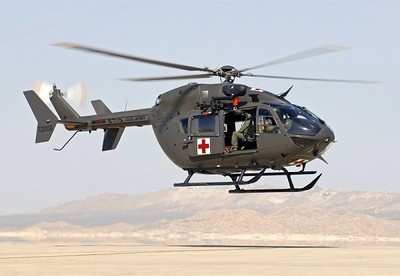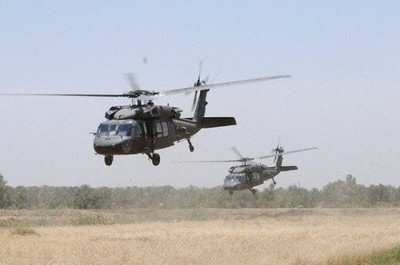Rotating Overseas As Units Receive UH-72A Aircraft
Some 23 Black Hawk helicopters have been freed from duty in the
United States to go to combat elsewhere, thanks to stateside
delivery of UH-72A Lakota helicopters. As Lakotas are fielded, said
Col. John Thurgood, project manager for Army utility helicopters,
they take Black Hawks out of the mix and send them back to
combat.

"As we field the UH-72A, we are able to take Black Hawks at some
of those units and give them back to combat units, and those combat
units take those aircraft to the fight," Thurgood said. "So the
Lakota is a very important part of our Army strategy to make sure
our combat units have what they need. And to make sure our states,
our governors, our homeland-security missions have what they need
-- this platform delivers all those things," he continued.
Thanks to delivery of Lakotas, about one assault battalion of
Black Hawks have been freed to return to combat, Thurgood said,
about half of a combat aviation brigade. Thurgood, along with John
Burke, program manager for EADS North America's light utility
helicopter program, spoke April 20, 2011, at a press conference
regarding the Lakota program during the 2011 Army Aviation
Association of America's Annual Professional Forum and Exposition
in Nashville, TN.
Thurgood said the Army has been pleased with both the aircraft
and with contract performance. "They have been doing a tremendous
job of producing every aircraft on time, or early," he said.
"That's very important to us." Thurgood said the Army plans to
purchase about 345 Lakotas, and today, about 154 have been
delivered. "We are about halfway through the delivery of this
program and doing it exactly on the cost and schedule that the Army
asked it to do."
The Lakota is a slightly modified version of the manufacturer's
commercial EC145 aircraft. "We literally chose the EC145, painted
it green, and we've only added to it -- the basic aircraft -- one
thing, and that's an ARC-231 radio," Thurgood said. The Army "knew
what they wanted and they have held to that requirement," Thurgood
said regarding the Lakota. "Holding ourselves to that requirement
without changing it really gives the program managers a lot of
flexibility to use best business practices."

Variants of the Lakota include a two-litter medical version, a
VIP version used in the National Capital Region, a security and
support version used for state missions by National Guard units,
and a version used by "opposing forces" during at combat training
centers. The S&S version of the aircraft, on display at the
AAAA convention, sported a mission equipment package with a search
light, a GPS navigation system that allows pilots to find locations
by street address as well as military grid coordinates, and a
visual sensor ball that can transmit imagery to a ground
station.
Thurgood said there will be small continuous modifications for
the Lakota -- the sensor ball might become obsolete, for instance,
and may be changed eventually. But because the Lakota is
essentially a commercial product, the manufacturer is incentivized
to do continuous improvements on their version of it --
improvements the Army can opt to buy into without having to fund.
"If they decide to put on a new tilt rotor system then the Army
gets to take advantage of that without the investment to do that,"
he said.
Conversely, for an aircraft like the Black Hawk -- the Army must
pay for such modifications, Thurgood said.
Right now, the Lakota is fielded to National Guard units for
state support, disaster relief and homeland defense, and in the
active component where it's used in non-deployable units for
medical evacuation and at training centers, for instance.
"There is no better aircraft in the military's inventory right
now for domestic operations -- there is none," said Chief Warrant
Officer 3 Kevin Mudd, Utility Helicopters Project Office, Redstone
Arsenal, Ala. "With its communications, sensors, and ability to be
in a location you're not used to and still function and complete
your mission -- this is the premiere domestic-operation platform
right now."
 OSH25 Day Four Redux: Spirit SE-1!, H55 eFlyer, King Schools
OSH25 Day Four Redux: Spirit SE-1!, H55 eFlyer, King Schools ANN Thanks Our Speedy Sponsor... Blackshape!!!
ANN Thanks Our Speedy Sponsor... Blackshape!!! Alpha Systems AOA Guides ANN Oshkosh Coverage
Alpha Systems AOA Guides ANN Oshkosh Coverage Pilot Mall Intro's High Flying Models To ANN Sponsor Lineup
Pilot Mall Intro's High Flying Models To ANN Sponsor Lineup CiES Fuels ANN's Oshkosh 2025 Special Event Coverage
CiES Fuels ANN's Oshkosh 2025 Special Event Coverage




